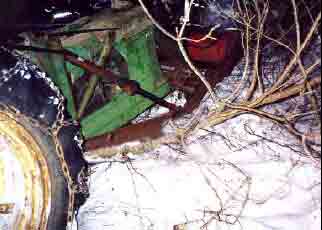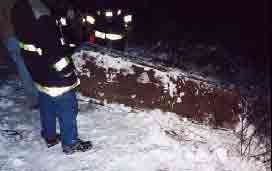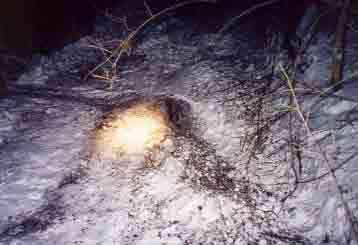Part-time Metal Salvager Died when Crushed in Tractor Overturn with Loader
Iowa Case Report: 05IA004
Report Date: September 23, 2005
Summary
A part-time scrap metal collector, age 50, was killed at the beginning of 2005 when the tractor he was operating overturned on the downward slope off the outer edge of an old path cut into the side of a bluff. He had been contacted to remove scrap metal from the back of a neighbor’s property. The tractor had a tricycle-type front axle with a front-end loader mounted to its frame but did not have a rollover protective structure (ROPS). He salvaged an open, metal tank of the kind typically used for watering livestock, lifted it with the loader and steered the tractor back down the steep trail. The tank repeatedly came free from the loader. In the process of reloading the tank, then backing the tractor to reset his direction on the trail, the tractor’s rear wheels spun in reverse gear and slipped off the trail’s edge. The tractor-loader combination overturned, coming to rest on its top against a small tree. The tractor operator was pinned between the tractor and the tree with the lift arm of the loader frame across his abdomen (Photo 1). His brothers who worked with the victim in their scrap metal salvaging enterprise found him hours later, after midnight. Emergency medical services were called and arrived within ten minutes. No life signs were detected and it was determined the victim died at the scene.

|
|
Photo 1 – Victim (not shown) was pinned against tree with loader frame across his abdomen.
|
RECOMMENDATIONS based on our investigation are as follows:
- All tractors used with front-end loaders should be equipped with a ROPS and seat belt.
- ROPS should be designed for all tractor makes and models in common, productive use and owners should have ROPS installed or retire these tractors from active use.
- Tricycle-type, narrow-front tractors should not be equipped with front-end loaders. Tractors equipped with a front-end loader should be used with special caution, and preferably only on level ground, have a wide front axle, rear wheels set as wide as possible, and adequate counter weights installed.
- Tractor operators should be aware of the overturn hazard and how to reduce the hazard and associated risk, including securing loads and ballasting with counterweight.
- Operators should use extreme caution when operating tractors on or near steeply sloping terrain and on pathways with ditches or embankments
- A communication plan should be established and implemented when the work to be done includes working alone.
Introduction
A northeast Iowa man who worked part time in a scrap metal business with his brothers was fatally crushed in the winter of 2005. His tricycle-front tractor with front-end loader went off a narrow trail cut from the side of a bluff and overturned while transporting a thin-walled, metal tank of the kind typically used for watering livestock. Iowa FACE investigators learned of this incident through a newspaper press clipping. Initial contact was made with the local police department within ten days of the incident. Additional information was obtained from the County Sheriff’s Office and the Medical Examiner’s Office. Telephone interviews were conducted with family members.
The victim was an experienced tractor operator known for his ability to repair them and his preference for old, two-cylinder tractors over newer models. The tractor involved in this incident, and the remainder of his collection of two-cylinder tractors, was subsequently sold at auction.
The leaves had fallen exposing the round-topped bluffs (Photo 2) that surrounded the town where this parttime metal salvager lived. His assigned task for the morning was to drive his tractor with loader a few short blocks to the edge of town and go up the bluff to collect some scrap metal from the back of a neighbor’s property. On the way down the bluff his tractor overturned pinning him underneath.
 |
|
Photo 2 – Topography in vicinity of incident
(August 2005). |
Investigation
This man collected scrap metal in a part-time business enterprise with his brothers. He also performed other occasional jobs for hire in the community and for local farmers. His full-time work was in the building construction industry. A neighbor had requested help to haul away some scrap metal, in particular, a thin-walled metal water tank of the kind typically used for watering livestock.
It was not uncommon for these brothers to frequently talk about their salvage business over the telephone during the course of their work. It was also not uncommon for them to be out of touch when there was no cellular telephone service, or when they were busy, or for them to work through mealtimes or return late from attending to their business. The brothers had separate tasks the day of the incident but planned to meet for noon lunch in a nearby town. The Victim’s wife was also out of town for the day.
The trail had long ago been cut from the side of the bluff and an overgrowth of brush bristled from its edges. The tractor he drove was a “two-cylinder” manufactured during the early-to-mid 1950’s with a hand-operated clutch control located to the right of the steering wheel. It had a narrow (tricycle-type) front axle and a front-end loader mounted to its frame, but did not have a ROPS. Tire chains had been installed on the rear wheels for additional traction in the slippery conditions. There was no fluid for ballast weight in the rear tires and no additional counterweight on the rear axle or hitch of the tractor.
He drove his tractor to the edge of town and navigated his way up the steep trail to the back of his neighbor’s property to salvage the thin-walled, metal water tank. It was an open, oval-shaped tank about 8 feet (2.4m) long, 2-3 feet (0.6m – 0.9m) deep and about as wide (Photo 3). He emptied snow and debris from the tank, then hoisted it with the loader and steered forward down the trail.

|
|
Photo 3 – Metal stock watering tank at outer edge of trail.
|
Apparently, control of this light but awkward load was difficult to maintain. Markings on the ground indicate the tank had to be retrieved and reloaded at least twice along the upper portion of the trail. Tire skid marks on the path immediately before the incident site suggest the application of the tractor’s brakes as one might do if the load was about to come loose. In the process of retrieving the tank which may have fallen or been brushed loose toward the outside edge of the trail, the tractor with its loader was positioned at a slight angle to the trail, aimed toward the tank and somewhat toward the ravine which sloped steeply downward from the trail’s outer edge.
Marks on the trail made by rear wheels spinning indicate he placed the tractor’s transmission in reverse, engaged the hand clutch and began backing up aggressively to reposition the tractor, its loader and load, on the narrow pathway (Photo 4). Chains around the tractor’s rear wheels dug into the snow and ice backing up the grade of the trail. The rear of the tractor slipped to the right on the trail and away from the bluff as the wheels continued to churn. First the right rear wheel then the left went off the outer edge of the trail. The tractor and front-end loader overturned down the wooded hillside coming to rest upside down 40 feet (12m) down hill from the trail.

|
|
Photo 4 – Tracks of spinning rear wheels as tractor backed up grade of trail then slid to its right off edge of trail.
|
During the overturn, the man either jumped or was thrown from the operator’s station. His lower body was subsequently pinned across a small, bent-over tree. With the rear of the tractor swung somewhat downhill, his legs were partly under the tractor hood near its exhaust stack with the lift arm of the raised loader across his abdomen. The loader was in a partially raised position with the bucket about the same height above level ground as the top of the tractor’s hood.
The man did not meet his brother for lunch at noon. He was not home when his wife returned in the late evening. Separately, these were not considered highly unusual. His wife called his brother when she awakened after midnight and discovered the man was still not home. The brothers typically knew each other’s work plans so they knew where to start searching. They called for emergency medical assistance when they found him. Local fire rescue, police, and sheriff’s personnel were dispatched and the first responder arrived within ten minutes. No life signs were detected and it was determined the victim died at the scene.
Cause of Death
According to the autopsy, the official cause of death was “traumatic crushing injuries to the abdomen”.
Recommendations/Discussion
Recommendation #1 All tractors used with front-end loaders should be equipped with ROPS and seat belt.
Discussion: ROPS are known to be extremely effective in reducing deaths in tractor overturns. Most agricultural tractors manufactured for North America after 1985 have ROPS, yet half the tractor fleet in current productive use in the US does not have rollover protection installed. Studies have shown risk-elevating factors for overturns include narrow front (tricycle-type front axle design), using a front-end loader, and operating the tractor on steeply sloped or uneven ground. The tractor in this incident was an older model with tricycle-type front axle and a front-end loader. It is especially important that such elevated-risk combinations of equipment used for loading, mowing, or transport, particularly on sloping or uneven ground, be equipped with ROPS.
Recommendation #2 ROPS should be designed for all tractor makes and models in common, productive use and owners should have ROPS installed or retire these tractors from active use.
Discussion: A ROPS for the tractor in this incident is currently not commercially available. While most non-ROPS tractors in current productive use do have a ROPS available for them, some models are difficult to retrofit due to the characteristics of the rear axle housing, ROPS attachment points, and connection strength considerations. It is important that a ROPS designed for this model tractor comply with applicable standards and regulations, be certified for use on this tractor, and be properly installed. The ROPS for some tractors may need to be a four-post design making it more costly to manufacture and install than the more common two-post ROPS.
Recommendation #3 Tricycle-type, narrow-front tractors should not be equipped with frontend loaders. Tractors equipped with a front-end loader should be used with special caution, and preferably only on level ground, have a wide front axle, rear wheels set as wide as possible, and adequate counter weight installed.
Discussion: The combination of a front-end loader on a tractor with tricycle-type front axle has been found to be high risk as indicated by many previous FACE case reports. This tractor configuration was very popular in the 1950’s. In 1993, there were fewer than 10,000 of this model tractor in use and many, whether or not they had been refurbished, were prized more as antiques than tractors for productive use. Tricycle-type tractors are more prone to overturns than tractors with wide-front wheel spacing and should not be used with front-end loaders or other attachments that significantly and adversely shift the center of gravity forward and/or upward. Raising or supporting a heavy load with the front-end loader bucket shifts additional weight from the back wheels to the front, moves the center of gravity for the tractor-loader combination forward, and decreases the combination’s basic stability compared to a tractor without a loader.
Recommendation #4 Tractor operators should be aware of the overturn hazard and how to reduce the hazard and associated risk, including securing loads and ballasting with counterweight.
Discussion: Regular participation in educational training with safety content can assist in the recognition of hazards and hazardous situations. It can also help identify measures to prevent or minimize the impact of exposure to the tractor overturn hazard and factors that contribute to the risk of an overturn, injury, or death. Fluid in the tires for ballast, additional weights on the axle, and/or weight on the tractor’s hitch sufficient to counterbalance the maximum loader capacity should always be in place when the tractor has a loader installed on it. This improves the location of the center of gravity for basic stability as well as adds weight to the rear wheels for improved traction. Proper attachments and means to secure loose, awkward, or shiftable loads should be used to prevent losing control of the load.
Recommendation #5 Operators should use extreme caution when operating tractors on or near steeply sloping terrain and on pathways with ditches or embankments.
Discussion: Losing and having to reload and regain control of the tank multiple times along the upper section of the trail would frustrate and irritate many tractor operators. Repeated difficulty could have been prevented if the load had been secured or if different equipment such as a trailer had been used. Tractors used on or along steeply sloping terrain should be equipped with ROPS.
Recommendation #6 A communication plan should be established and implemented when the work to be done includes working alone.
Discussion: It is important, especially when working alone, that others know your task,
location, and when contact (notification) will again be made. A cellular phone or two-way radio is a
good way to keep in touch. When difficulty with the task requires assistance, or when dictated by
safety concerns, help can be summoned. If an appointment is missed or contact is late, others can
make contact or visit the location. In this case, since there were no post-overturn event indications
that the victim struggled to free himself, notification may not have been possible and swift rescue
response would not likely have had an impact on the outcome.
References
- ASAE Standards. 2001. S383.1: Roll-Over Protective Structures (ROPS) for Wheeled Agricultural Tractors. St. Joseph, Mich.: ASAE.
- ASAE Standards. 2004. S355.3: Safety Practices for Agricultural Front-End Loaders. St. Joseph, Mich.: ASAE.
- Bean, TL. Safety with Front End Loaders. West Virginia University Extension Service. Available at: www.cdc.gov/nasd. Accessed 24 May 2005.
- Cyr, DL. and S. B. Johnson. Front End Loader Safety. University of Maine Cooperative Extension. Available at: www.cdc.gov/nasd. Accessed 24 May 2005.
- Myers JR, Snyder KA. Roll-over Protective Structure use and the cost of retrofitting tractors in the United States, 1993. Journal of Agricultural Safety and Health. 1(3):185-197, 1995.
- NASD. The Lone Worker! Atlanta, GA: Centers for Disease Control. National Agricultural Safety Database. Available at: http://www.nasdonline.org/index.htmlexternal icon. Accessed 23 September 2005. (Link updated 8/5/2009)
- Deere & Company. 1983. Materials Handling Equipment. In Agricultural Safety – Fundamentals of Machine Operation, 284-286. Moline, IL.
- The Ohio State University Extension. Loader Safety – Part of Ohio State University Extension’s Agricultural Tailgate Safety Training Series. Ohio State University Extension. Available at: http://www.nasdonline.org/index.htmlexternal icon. Accessed 24 May 2005. (Link updated 8/5/2009)
Iowa FACE Program
Fatality Assessment and Control Evaluation, FACE, is a program of the National Institute for
Occupational Safety and Health (NIOSH), which is part of the Centers for Disease Control and
Prevention of the U.S. Department of Health and Human Services. Nationally, the FACE program
identifies traumatic deaths at work, conducts in-depth studies of select work deaths, makes
recommendations for prevention, and publishes reports and alerts. The goal is to prevent
occupational fatalities across the nation.
The NIOSH head office in Morgantown, West Virginia, carries out an intramural FACE case
surveillance and evaluation program and also funds state-based programs in several cooperating
states. In Iowa, The University of Iowa through its Injury Prevention Research Center works in
conjunction with the Iowa Department of Public Health and its Office of the State Medical Examiner
to conduct the Iowa FACE program.
Nationally, NIOSH combines its internal information with that from cooperating states to provide
information in a variety of forms which is disseminated widely among the industries involved.
NIOSH publications are available on the web at https://www.cdc.gov/NIOSH/FACE/ and from the
NIOSH Distribution Center (1-800-35NIOSH).
Iowa FACE also publishes its case studies, issues precautionary messages, and prepares articles
for trade and professional publication. In addition to postings on the national NIOSH website, this
information is posted on the Iowa FACE site, http://www.public-health.uiowa.edu/FACE/external icon. Copies of
FACE case studies and other publications are available by contacting Iowa FACE, too.
The Iowa FACE team consists of the following specialists from the University of Iowa: Craig
Zwerling, MD, PhD, MPH, Principal Investigator; John Lundell, MA, Co-Investigator; Murray
Madsen, MBA, Chief Trauma Investigator; and Co-Investigator/specialists Risto Rautiainen, PhD,
and Wayne Sanderson, PhD, CIH. Additional expertise from the Iowa Department of Public Health
includes Rita Gergely, Principal Investigator, and John Kraemer, PA, from the Office of the State
Medical Examiner.
To contact Iowa State FACE program personnel regarding State-based FACE reports, please use information listed on the Contact Sheet on the NIOSH FACE web site Please contact In-house FACE program personnel regarding In-house FACE reports and to gain assistance when State-FACE program personnel cannot be reached.

